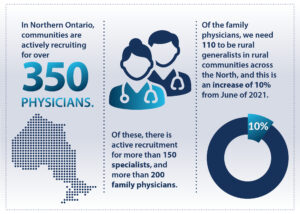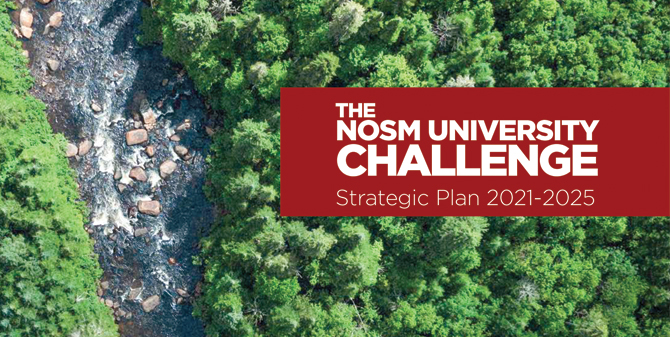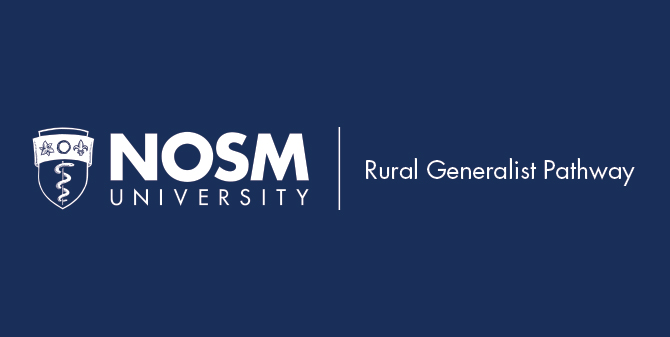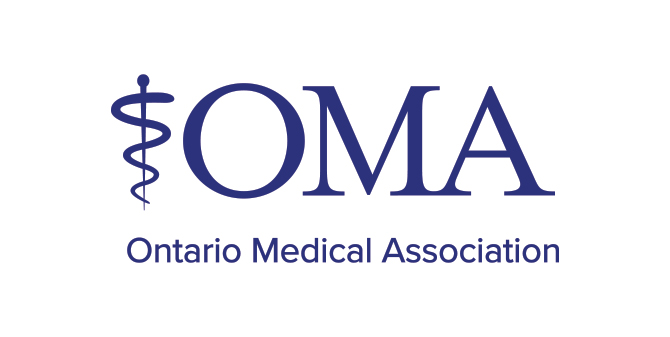
“We must eliminate the gaps in Northern Ontario health human resources in order to achieve equitable and sustainable access to quality health care.”
Dr. Sarah Newbery
Associate Dean, Physician Workforce Strategy
physicianworkforce@nosm.ca
@NOSMMDworkforce
The health and wellbeing of Northern Ontarians depends on having timely access to physicians and other healthcare providers, to meet the diverse needs of the people.
In June of 2024, Northern Ontario was actively recruiting for 417 physicians. This was an increase from recruitment needs of 364 physicians in 2022 and 384 in 2023.
As with many places, the need for family physicians across our communities has increased and, as of June 2024, we were recruiting for more than 200 family physicians across Northern Ontario, the majority of these in rural communities.
Specialties in highest need include: obstetrics, pediatrics, anaesthesia, general internal medicine, psychiatry, general surgery and emergency medicine (*although many of these physicians may be family physicians who work in ER).
At NOSM University, we are working hard, alongside partners to reverse this trend and ensure that communities and citizens have the physicians that they need to improve care and health outcomes.
What do we know about our current needs?
We are working closely with community-based recruiters and hospital partners to understand what we are recruiting for across the North for physicians.
The data is an UNDERESTIMATE of need and if we are truly to transform health care delivery to meet the needs of Northern Ontario, there is much work to be done to forecast and measure the population need.
This data is imperfect, but it is the best we have available. To understand the data:
- We need to keep in mind that the data reflects only current contract vacancies and there are challenges about whether current funding allocations meaningfully reflect the number of physicians required to meet the health needs of the population.
- The recruitment of specialists in Northern Ontario’s large centres takes place largely through hospitals and so the data does not completely reflect the need for specialists outside of the hospital setting.
Examples of likely gaps are in the need for allergy specialists, rheumatologists and addiction medicine physicians who may be largely in the community rather than hospital.
- The data does not include any forecasting information nor the unmeasured and unmet need of some of our communities.
- The current need also reflects only the clinical service requirements and does not include the expectations of participation in teaching or other scholarly work that is expected of physicians who are working with a medical university like NOSM University.
So the data is an UNDERESTIMATE of need and if we are truly to transform health care delivery to meet the needs of Northern Ontario, then we will need more physicians than is noted here. At present however, this is the best estimate for unmet need for physicians that we have.
What is NOSM University’s role in the development of physician resources for Northern Ontario?
NOSM University’s role falls broadly in four domains:
- Education and training of future clinicians – both through NOSM University’s programs and through elective and core rotation placements for learners from other schools
- Facilitating the retention of skilled faculty through career and academic opportunities
- Collaboration with health system partners for planning, advocacy and alignment
- Collaboration through formal and informal agreements with other Ontario universities to increase clinical placements of core and elective learners in Northern Ontario
NOSM University offers several Family Medicine and Royal College Specialty Postgraduate Programs. Learn more.
Physician HHR Data for 2023
As of June 2023, based on data gathered from community and hospital level recruiters, Northern Ontario was recruiting for 384 physicians including:
More than 200 family doctors – most of which are needed as rural generalists in our rural communities.
- 180 specialists with those we need in highest numbers being:
- Psychiatrists (24)
- General Internists (22)
- Pediatricians (7)
- Anesthetists (15)
- General surgeons (13)
- Emergency physicians (either CCFP EM or FRCPC) (>15)
Smaller numbers in key subspecialties like rheumatology, respirology, physiatry, sleep medicine, interventional cardiology, dermatology, and several others are also needed. Although smaller numbers are needed, these subspecialists are critical to health care services in Northern Ontario.
Expand the heading below to view previously reported data.
Physician HHR data – June 2022
In Northern Ontario, communities are actively recruiting for over 350 physicians. Of these, there is active recruitment for more than 150 specialists, and more than 200 family physicians. Of the family physicians, we need 110 to be rural generalists in rural communities across the North, and this is an increase of 10% from June of 2021.

- The specialists we need in highest numbers are:
- Psychiatrists
- General Internists
- Pediatricians
- Anesthetists
- Diagnostic imaging specialists
- Emergency physicians (either CCFP EM or FRCPC)
Smaller numbers in key subspecialties like rheumatology, respirology, physiatry, sleep medicine, interventional cardiology, dermatology, and several others are also needed. Although smaller numbers are needed, these subspecialists are critical to health care services in Northern Ontario.
Expand the heading below to view previously reported data.
Physician Human Health Resource Data – June 2021
Breakdown of the 325 physicians needed:
|
The specialists we needed in highest numbers were:
|
For more information about working as a physician in N. Ontario
Contact Information
Email: physicianworkforce@nosm.ca










